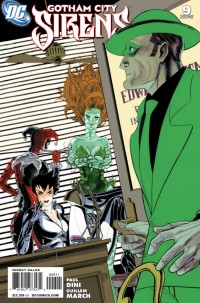GOTHAM CITY SIRENS #9
What did the
iFanboy
community think?
Pulls
Art and cover by Guillem March
Size: 32 pages
Price: 2.99
In which I write a review whilst I read a comic book.
The first page is a full splash, it treats the cover as it’s previous panel. This is one of the more rare features that come along with the use of one consistent artist, cover to interior. Not only does the cover image accurately represent the style of it’s comic-y insides, it is actually part of the story. This storytelling technique is mirrored (the cover acts as the final panel) in James Jean’s cover for Fables #76 (Vertigo). That may be a poor reference point since the Allred interiors were a stylistic contrast to Jean’s cheery scene. Back on track…
In this first scene, writer Paul Dini wastes no time setting the narrative stage while having fun with the character dynamics present (Poison Ivy, Catwoman, Harley Quinn, and the still-reformed Edward “The Riddler” Nigma). What’s this about a dead body our girls have discovered? The story will unfold, to the reader and the Riddler, from multiple perspectives (“Puzzle Pieces” being the title). Harley’s take first…
March can draw ladies. His visuals are hyper-realized but damn, are they easy on the eyes. While the narrative moves between flashbacks, a scene back in the office of Nigma, P.I. divulges some insight to the tortured thoughts of these reformed criminals. These characters are learning about themselves, discovering their limits and personal needs… growing. Cut to an all-silent, two-page Catwoman and Wildcat gato-a-gato face-off. Cool! The inks in this action scene portray movement with far more success than many detail-styled artists do. Back in the present, March’s heavy use of shadow underlines Dini’s words perfectly: we’re exploring our characters stains, the darkness that hangs on them as they try to live normal, even heroic, lives.
The framing story now becomes the main plot. Nigma is on the case and, as a detective, he’s top notch. While the tortured heroes of similar detective stories commonly battle with booze, our man is fighting off his own demon in a bottle: criminal tendencies. While detecting and deducing, the Riddler comes across the true threat… some character I’ve never ever heard of. I won’t spoil it here, but this ending went off the rails a bit for me. The reveal was unexpected, but also unexciting. I’ll withhold judgement til next issue since Gaggy the little-known ex-Joker side-kick had almost the same effect on me when he appeared in earlier issues.
Now that my wheels are turning about past issues, it’s clear to me that we’re 9 issues in to this series without a major over-arching plot to steer us. This may throw some off the scent of this series, but it’s a welcome diversion to me. While most of the DC universe is tied up in continuity, it’s refreshing to read the one to 3 issue story arcs found in these pages. Fellow DC books Jonah Hex and Power Girl continually affirm that tie-in-free titles are some of the most fun the industry has to offer. While it’s impact on the larger events may be little to none, the gorgeous art (did I mention March’s ladies?) and character-driven tales will keep me following the song of “Sirens” to certain shipwreck.
Art: 5 - Excellent




Leave a Comment
Login or Register to get involved and leave a comment